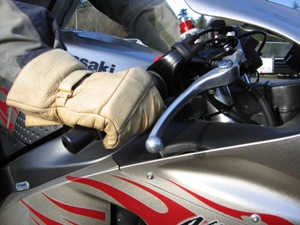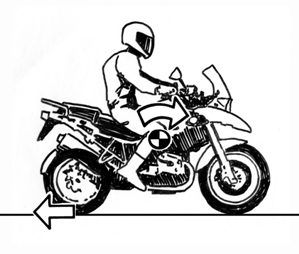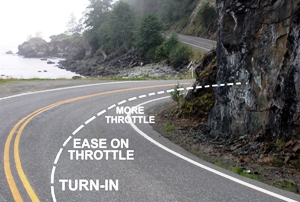 Road Science: Cornering Control
Road Science: Cornering Control
Part 3, The Throttle
...continued from Part 2
When and how you roll on the throttle—or roll off the throttle—has a lot to do with cornering control. For instance, imagine leaning a 100 hp bike into a tight turn, and then suddenly rolling on a big handful of throttle. The rear tire may already be close to the limits of traction, and a sudden increase in power would very likely slide the rear end out. That example makes it obvious that engine thrust can push the bike around.
 In a corner, it would be best to maintain the weight distribution on the tires. Even if the bike is in a straight line, rolling on the throttle tends to shift weight onto the rear wheel. Rolling off the throttle shifts weight toward the front. That same front-rear weight shift occurs in a corner. To maintain traction, it would be best to maintain weight distribution while leaned over.
In a corner, it would be best to maintain the weight distribution on the tires. Even if the bike is in a straight line, rolling on the throttle tends to shift weight onto the rear wheel. Rolling off the throttle shifts weight toward the front. That same front-rear weight shift occurs in a corner. To maintain traction, it would be best to maintain weight distribution while leaned over.
Rolling on the throttle shifts weight toward the rear, decreasing front tire traction.
 Let's note that even if the tires don't seem to be sliding sideways on the pavement during a curve, they are. In a curve, the flexible tire rubber allows the bike to move in a slightly different direction from where the wheels are pointed. It's called "drift," or more correctly "side slip." Rolling on a bit more throttle tends to increase the slip angle of the rear wheel, pointing the bike more toward the curve.
Let's note that even if the tires don't seem to be sliding sideways on the pavement during a curve, they are. In a curve, the flexible tire rubber allows the bike to move in a slightly different direction from where the wheels are pointed. It's called "drift," or more correctly "side slip." Rolling on a bit more throttle tends to increase the slip angle of the rear wheel, pointing the bike more toward the curve.
Rolling off the throttle shifts weight toward the front, decreasing rear wheel traction.
Braking also affects side slip. Imagine jamming on the rear brake while leaned over. It's not difficult to imagine the rear tire sliding out, dropping the bike on its "low" side. Let's note that rolling off the throttle is also rear wheel braking, as engine compression tries to slow the rear wheel.
Tire Contact Rings
As the bike leans over into a curve, the location of the tire contact rings moves off center. That means that engine thrust or braking are off center. So, rolling on or off the throttle while leaned over will push or pull on one side of the rear tire, and that will have an effect on steering the bike. 
Not only does a tire's contact ring ("contact patch") move off center as the bike leans over, the ring shrinks in diameter. Even if you're attempting to hold a steady throttle, the bike will decelerate as it leans over onto the smaller-diameter contact rings. To maintain bike speed, you'll need to roll on a bit more throttle as you lean the bike over. One of the advantages of wide, low-profile tires is less change in contact ring diameter, but the tradeoff is the ring moving farther out to the side as the bike leans over.
As the bike leans over toward a curve, the contact ring of the tires is reduced in diameter, and also moves off center.
Put all of this together, and you can see that throttle control affects steering, whether accelerating or decelerating. As it happens, throttle control and cornering lines can work together. If you're following a nice "delayed apex" line, you can ease on the throttle as you turn the bike in, and then gradually roll on more throttle through the rest of the curve. That's much smoother than decelerating toward a mid-curve apex on a trailing throttle, and then getting back on the throttle while leaned over.
The ideal throttle control would be decelerating toward the turn-in point while in a straight line, then easing on the throttle as you lean the bike over. You can continue to ease on more throttle in the last half of the curve, since the bike will be straightening up, and the side loads on the tires will be decreasing.
 Throttle-Brake Transitions
Throttle-Brake Transitions
With the bike leaned over into a turn, maintaining traction is a top priority. And how you roll on or off the throttle can determine whether you keep the tires hooked up, or they slide out.
Sudden changes in throttle momentarily demand traction. That is, if you were to suddenly roll the throttle open while leaned over, the rear tire would demand more traction as it attempts to accelerate the bike forward. It's very possible to slide the rear tire out from overzealous roll-on.
Easing on the throttle as you lean the bike, and then continuing to ease on more throttle through the curve helps stabilize the bike and avoid mid-turn wobbles.
Sudden braking input also demands traction. If you were to suddenly jam on the rear brake while leaned over into an aggressive curve, you should expect the rear tire to slide out. What may not be obvious is that suddenly snapping the throttle closed has an effect similar to stepping on the rear brake pedal. We must also remember that accelerating or braking both cause weight transfer between the two tires, and that changes the traction available on either tire.
To help maintain traction, both throttle input and braking should be as smooth as possible. When rolling on the throttle, it should be gradual. It's just as important to roll off the throttle smoothly. Likewise, when braking, you should apply the brakes progressively over approximately two seconds. And when releasing the brakes, you should ease them off over two seconds.
 You can practice smooth throttle and brake application in a straight line exercise. At a speed of say, 40 mph, ease the throttle closed as you progressively squeeze on the front brake. Don't clutch or shift down. As the bike decelerates to about 20 mph, ease off the brake as you smoothly roll back on the throttle. The goal is to transition from throttle to brakes and back to throttle so smoothly that the bike isn't upset.
You can practice smooth throttle and brake application in a straight line exercise. At a speed of say, 40 mph, ease the throttle closed as you progressively squeeze on the front brake. Don't clutch or shift down. As the bike decelerates to about 20 mph, ease off the brake as you smoothly roll back on the throttle. The goal is to transition from throttle to brakes and back to throttle so smoothly that the bike isn't upset.

Smooth braking helps manage traction, whether straight up or leaned into a corner. Squeeze the lever progressively harder over about two seconds. When releasing the brake, ease it off over two seconds.
Controlling the throttle and brakes simultaneously requires some right hand dexterity. You'll have to find a technique that works for you. Some riders prefer to hold the throttle with thumb and forefinger and brake with the three outer fingers. Others prefer to hold the throttle with thumb and outer two fingers, and brake with the two inner fingers. Which fingers you use for braking may depend upon the force needed at the lever on the bike you're riding.
Two-fingered braking works well for machines with a powerful front brake. The throttle is held between the thumb and outside fingers.
 You can expect surface traction to change, even during a corner. A patch of sand or dribble of diesel oil will reduce traction, and you can feel a momentary slip of either or both tires. The typical (and wrong) "survival reaction" when a rider feels a tire slip sideways is to snap the throttle closed, but that can turn a short slide into a major crash. If the tire can regain traction, it will. It's difficult to resist the urge to snap off the throttle, but it's important to hold a steady throttle and steer toward the direction of the skid.
You can expect surface traction to change, even during a corner. A patch of sand or dribble of diesel oil will reduce traction, and you can feel a momentary slip of either or both tires. The typical (and wrong) "survival reaction" when a rider feels a tire slip sideways is to snap the throttle closed, but that can turn a short slide into a major crash. If the tire can regain traction, it will. It's difficult to resist the urge to snap off the throttle, but it's important to hold a steady throttle and steer toward the direction of the skid.
For greater leverage, some riders prefer squeezing the brake lever with the three outside fingers, and holding the throttle with the thumb and index finger.
Uphill, Downhill
While the ideal technique for level turns is to gradually ease on more throttle from turn-in through the exit, uphill and downhill turns require different tactics. When approaching an uphill turn, especially a tight switchback, the front end will be lighter and therefore the front tire will have reduced traction. Rolling on the throttle during a tight uphill turn can cause the front tire to slide out. That's especially likely when carrying a passenger or a heavy load of gear on the back of the bike.
When approaching a tight, uphill turn, maintain a slightly higher speed, to allow inertia ("momentum") to carry the bike up and around. Then smoothly ease on more throttle as you pull the bike upright.
When cornering downhill, you may need to brake to keep speed from increasing. Riding downhill, the front tire will be more heavily loaded, so you can use more front brake in downhill corners. If you're using engine braking to hold speed, remember, engine braking only applies to the rear tire, which already has decreased traction due to the forward weight shift.


Hiç yorum yok:
Yorum Gönder